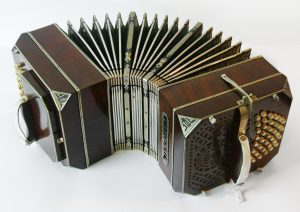Yesterday’s Music History Monday post focused on the accordion, an important patent for which was granted to the Philadelphia-based inventor Anthony Foss on January 13, 1854: 166 years ago yesterday.
As detailed in yesterday’s Music History Monday, for reasons having to do with class politics and pure snobbery, the accordion is often looked down upon – even derided – as a third-class instrument in the United States, something the high snark-content of my post did little to obviate. Part of the problem, as I explained, is that the accordion never inspired a critical mass of composers to create for it a repertoire of its own. And while this is true in the world of concert music, it doesn’t tell the whole story.

That whole story is this: there are certain genres of music that are entirely dependent upon the sound of the accordion (or one of its close relatives, like the concertina and bandoneón), to create their characteristic sonic ambience. For example, the polka: a moderately up-tempo dance in 2/4 time that originated in Czech lands in the early nineteenth century. By the mid-nineteenth century, what was called “polkamania” had spread across Europe, though it was most powerfully felt in central Europe: in Czech lands, Poland, and Germany. That period coincided with a huge influx of Czech, Polish and German immigrants to the American Midwest, where the polka remains virtually a way of life to this day; in Milwaukee, Wisconsin, the Beer Barrel Polka is played in lieu of Take Me Out to the Ball Game during the seventh inning stretch at Milwaukee Brewers baseball games.

The accordion is the principal instrument – and thus the principal instrumental sound – of zydeco music. Let me say this upfront: anyone who doesn’t know zydeco is missing out on one of the most exciting, virtuosic, and characteristically American genres of music in existence. Zydeco co-evolved in southwest Louisiana during the late nineteenth and early twentieth centuries with blues, ragtime, and jazz. Like blues, ragtime and jazz, zydeco is an “only in the Americas” synthesis of incredibly different musical elements. Created originally by speakers of the Louisiana French Creole language (a hybrid of predominately French and various native languages), zydeco synthesizes aspects of West African music, blues, ragtime, jazz, Louisiana Creole music, and the music of the native people of Louisiana into a whole a gazillion times greater than its parts. Check out the following video, which features Jeffery Broussard (playing a button, as opposed to a keyboard accordion) and the Creole Cowboys, performing a piece called Zydeco a Pas Sale, recorded in 2012.

And then there is Argentine (and, to a lesser extent, Uruguayan) Tango, the principal instrument of which is the bandoneón, a squeezebox-type instrument closely related to the accordion that uses buttons instead of a piano-style keyboard. Like blues, ragtime, jazz, and zydeco, tango music evolved during the late nineteenth and early twentieth centuries. Like blues, ragtime, jazz, and zydeco, tango is yet another “only in the Americas” synthesis of unlike musical elements: part European, part African, part native music, forged together in Buenos Aries and other port cities on the Río de la Plata, the estuary that separates Argentina and Uruguay. … which brings us to today’s Dr. Bob Prescribed recording. Continue reading, only on Patreon!
